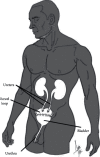Evaluation and Management of Genitourinary Emergencies in Patients with Cancer
- PMID: 34367695
- PMCID: PMC8337163
- DOI: 10.1155/2021/4511968
Evaluation and Management of Genitourinary Emergencies in Patients with Cancer
Abstract
Background: Genitourinary emergencies in cancer patients are common. Most cancer treatments are administered in the outpatient setting, and patients with complications often visit the emergency department. However, there is no recent emergency medicine literature review focusing on genitourinary emergencies in the oncologic population. Objective of the review. To increase awareness of common genitourinary emergencies in patients with cancer and enable the prompt recognition and appropriate management of these conditions. Discussion. Genitourinary emergencies in patients with cancer require a multidisciplinary approach to treatment. The most common genitourinary emergencies in patients with cancer are related to infection, obstructive uropathy, hemorrhagic cystitis, and complications associated with urinary diversions. The treatment approach in patients with infections, including viral infections, is similar to those without cancer. Understanding the changes in the anatomy of patients with urinary diversions or fistulas can help with the management of genitourinary emergencies.
Conclusions: Familiarization with the uniqueness of genitourinary emergencies in patients with cancer is important for emergency physicians.
Copyright © 2021 Demis N. Lipe et al.
Conflict of interest statement
The authors declare no conflicts of interest in this study.
Figures



Similar articles
-
Genitourinary Emergencies in Older Adults.Emerg Med Clin North Am. 2021 May;39(2):361-378. doi: 10.1016/j.emc.2021.01.003. Epub 2021 Mar 11. Emerg Med Clin North Am. 2021. PMID: 33863465 Review.
-
A Model Oncologic Emergency Medicine Curriculum for Residency Training.J Emerg Med. 2021 Sep;61(3):330-335. doi: 10.1016/j.jemermed.2021.02.037. Epub 2021 May 16. J Emerg Med. 2021. PMID: 34011452
-
Oncologic thoracic emergencies of patients with lung cancer.Rev Clin Esp (Barc). 2019 Jan-Feb;219(1):44-50. doi: 10.1016/j.rce.2018.06.011. Epub 2018 Sep 25. Rev Clin Esp (Barc). 2019. PMID: 30266451 English, Spanish.
-
Imaging Modalities in Genitourinary Emergencies.Emerg Med Clin North Am. 2019 Nov;37(4):785-809. doi: 10.1016/j.emc.2019.07.013. Emerg Med Clin North Am. 2019. PMID: 31563208 Review.
-
Neurologic emergencies in patients who have cancer: diagnosis and management.Neurol Clin. 2012 Feb;30(1):101-28, viii. doi: 10.1016/j.ncl.2011.09.004. Epub 2011 Oct 14. Neurol Clin. 2012. PMID: 22284057 Review.
References
-
- Nam R. K., Cheung P., Herschorn S., et al. Incidence of complications other than urinary incontinence or erectile dysfunction after radical prostatectomy or radiotherapy for prostate cancer: a population-based cohort study. The Lancet Oncology. 2014;15(2):223–231. doi: 10.1016/s1470-2045(13)70606-5. - DOI - PubMed
-
- Grasa V., Lainez N., Villafranca E. Emergency treatment of urological complications in cancer patients. Anales del sistema sanitario de Navarra. 2004;27(3):125–135. - PubMed
-
- Keane P. F., O’Kane H. F. Urological emergencies in the cancer patient—diagnosis and treatment. European Journal of Cancer Supplements. 2007;5(5):339–349. doi: 10.1016/s1359-6349(07)70062-9. - DOI
Publication types
LinkOut - more resources
Full Text Sources

